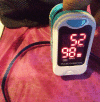What Affect Would Higher Oxygen Levels Have On The Color Of The Sky
Definition/Introduction
Loftier altitude oxygenation is improving oxygenation or enriching the body with additional oxygen at loftier altitudes.[1]
According to the Order of Mountain Medicine (Effects of loftier distance on humans), there are three altitude regions:
-
High distance = 1500 to 3500 meters above sea level (4900-11500 ft.)
-
Very high altitude = 3500 to 5500 meters above sea level (11500 to 18000 ft.)
-
Farthermost altitude = above 5500 meters in a higher place sea level (18000 ft.)
Mount Everest, the highest mountain on earth, is at 29029 anxiety above ocean level. It is in the farthermost altitude region. These three altitude regions correspond with different levels of depression oxygen in the atmosphere. At Mount Everest, the atmospheric pressure level is around 228 mmHg, but the percentage of fraction of inspired oxygen is the same as sea level, where the atmospheric pressure is 760 mmHg.
Problems of Concern
In addition to pilots, crew, and passengers of shipping, athletes, travelers (lowlanders) to ski resorts, mountaineering expeditions, and people going on pilgrimage to monasteries, abbeys, shrines, or temples are at high chance for developing acute mountain sickness or high altitude affliction. If untreated, it can lead to its severe manifestations: high–altitude pulmonary edema (HAPE) and loftier-altitude cerebral edema (HACE). High altitude oxygenation can help such people or those accompanying them acclimate to high altitudes, hence preventing or ameliorating the symptoms of high distance illness and/or the progression to severe illnesses. An distance generator tin can assist acclimatize to high altitudes in a bedroom past producing varying oxygen levels depending on the altitude level one plans to ascend. For instance, it can generate 20.9% oxygen at sea level to nine.5% oxygen at 20000 feet (6000 meters) above sea level.
Clinical Significance
High altitudes can cause depression oxygen saturation levels or desaturation of an private's claret. Information technology happens because of depression atmospheric pressure at loftier altitudes. Oxygen saturation levels refer to the extent hemoglobin is bound or saturated to oxygen. A small device chosen a pulse oximeter (prototype ane) measures the oxygen saturation level and pulse/60 minutes. This device is typically used on the index finger. Normal oxygen saturation levels are 95% to 100%. Oxygen saturation levels below 90% are considered aberrant.
Some symptoms of depression oxygen saturation levels include:
-
Shortness of jiff
-
Cyanosis
-
Extreme fatigue and weakness
-
Mental confusion
-
Headaches
Other causes of low oxygen saturation levels include blood hypoventilation (OSA and oversedation), 5/Q mismatch - pulmonary embolism, airway obstruction (chronic obstructive pulmonary affliction or COPD and sleep apnea), diffusion abnormalities (pneumonia, CHF, alveolar hemorrhage, emphysema, interstitial lung disease (ILD), astute respiratory distress syndrome (ARDS), and shunts (intra- and extra-pulmonary).
Blood oxygen saturation levels cannot go to a higher place 100%. It is not possible to achieve 100% oxygen saturation levels breathing room air. The just way to accomplish this is by breathing oxygen through medical devices (masks, Gamow bags, and tents) or homes with oxygen-controlled rooms like in some mountain homes in Colorado and other mountainous regions. Portable hyperbaric chambers are also used at loftier altitudes, especially during emergencies [2].
However, inhaling oxygen for a long time tin can cause adverse effects. These include retinopathy and blindness. Studies have indicated changes in corneal thickness in patients with high–altitude pulmonary edema subsequently systemic oxygen therapy.[3]
Recent epidemiological studies propose that taking coco-flavanol for a week increases prefrontal cortex oxygenation at rest and during moderate-intensity practise in normoxia and hypoxia.[4]
Drugs are likewise used in the prevention and treatment of high-altitude illnesses. Some of these can improve oxygenation. Acetazolamide is the almost common drug used to prevent high-distance disease.[5] Studies have shown that benzolamide improves oxygenation, reduces acute mount sickness, and has fewer side effects than acetazolamide.[half dozen]
Other studies demonstrate the effectiveness of dexamethasone in improving pulmonary hemodynamics in patients with COPD going to altitudes.[7]
Review Questions

Figure
This prototype show a Pulse Oximeter with 98% oxygen saturation level and pulse/HR of 52 bpm. Contributed past Tripthi K. Mathew, Md, MPH, MBA, PhD
References
- 1.
-
Due west JB. Improving oxygenation at high altitude: acclimatization and O2 enrichment. High Alt Med Biol. 2003 Fall;4(3):389-98. [PubMed: 14561244]
- 2.
-
Flaherty GT. Under pressure: facilitating the emergency use of portable hyperbaric chambers at distance. Travel Med Infect Dis. 2014 Sep-Oct;12(5):420-ane. [PubMed: 25246227]
- iii.
-
Patyal Southward, Yadav AK, Kotwal A. Changes in corneal thickness in patients with high-altitude pulmonary edema after systemic oxygen therapy. Indian J Ophthalmol. 2018 Nov;66(11):1554-1557. [PMC free article: PMC6213672] [PubMed: 30355859]
- iv.
-
Decroix L, Tonoli C, Lespagnol Due east, Balestra C, Descat A, Drittij-Reijnders MJ, Blackwell JR, Stahl W, Jones AM, Weseler AR, Bast A, Meeusen R, Heyman E. One-calendar week cocoa flavanol intake increases prefrontal cortex oxygenation at residue and during moderate-intensity exercise in normoxia and hypoxia. J Appl Physiol (1985). 2018 Jul 01;125(1):8-18. [PubMed: 29543135]
- 5.
-
Burtscher Thousand, Gatterer H, Faulhaber M, Burtscher J. Acetazolamide pre-treatment before ascending to loftier altitudes: when to start? Int J Clin Exp Med. 2014;7(xi):4378-83. [PMC gratuitous commodity: PMC4276215] [PubMed: 25550957]
- vi.
-
Collier DJ, Wolff CB, Hedges AM, Nathan J, Bloom RJ, Milledge JS, Swenson ER. Benzolamide improves oxygenation and reduces astute mount sickness during a high-distance expedition and has fewer side furnishings than acetazolamide at sea level. Pharmacol Res Perspect. 2016 Jun;4(3):e00203. [PMC gratuitous article: PMC4876137] [PubMed: 27433337]
- 7.
-
Lichtblau K, Furian M, Aeschbacher SS, Bisang One thousand, Ulrich Due south, Saxer Due south, Sheraliev U, Marazhapov NH, Osmonov B, Estebesova B, Sooronbaev T, Bloch KE, Ulrich Southward. Dexamethasone improves pulmonary hemodynamics in COPD-patients going to distance: A randomized trial. Int J Cardiol. 2019 May 15;283:159-164. [PubMed: 30638985]
Source: https://www.ncbi.nlm.nih.gov/books/NBK539701/
Posted by: clarkhisgrat.blogspot.com

0 Response to "What Affect Would Higher Oxygen Levels Have On The Color Of The Sky"
Post a Comment